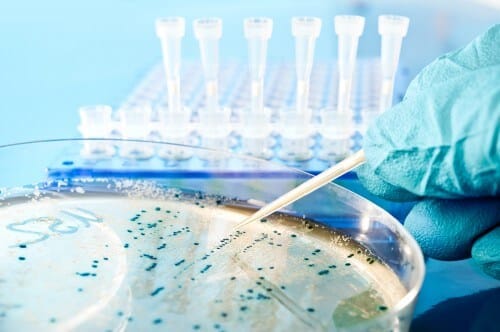An Israeli-American study inspired by a movie revealed, among other things, that the most resistant bacteria are not always the winners in the survival battles

Humanity is in a medical crisis. In the war between us and disease-causing bacteria, they have the upper hand. The bacteria exposed to antibiotics develop resistance against them - as predicted by the theory of evolution - and we are left without means of protection. In a study published in Science Researchers from Harvard Medical School and the Technion present a way to observe bacteria as they do this: they migrate around, encounter different concentrations of antibiotics and develop resistance against them.
The era of antibiotics, which has begun Almost 90 years ago Revolutionized medicine. Suddenly doctors had a powerful, safe and easy-to-use tool to eradicate bacterial diseases and save countless lives. But the effectiveness of this tool was short-lived - many species of bacteria have developed resistance to the treatment and now we seem to be facing the end of this era.
In Israel at least 5,000 people die every year from resistant bacteria contracted in hospitals. Just in the last few months We were informed Because E coli bacteria were discovered in the United States (Escherichia coli) are resistant to colistin, a "last resort" antibiotic. US Centers for Disease Control and Preventionwarned Because soon we won't be able to treat the bacteria Neisseria gonorrhoeae, the cause of gonorrhea, and even the World Health Organization Treat To that.
The rapid emergence of antibiotic resistance is a beautiful example of evolution by natural selection. Like any other creature, whenever bacteria reproduce, DNA changes, mutations, can occur. Sometimes, if the bacterium is particularly lucky, such a mutation will give it some resistance to antibiotics.
When we use antibiotics it destroys the bacteria that are sensitive to it, but the resistant mutants survive. Since they can migrate and utilize resources in areas that are blocked to their sensitive brothers - they also thrive. With every unnecessary use of antibiotics (in agriculture and medicine) and every time we stop treatment prematurely, we help the resistant bacteria to thrive and spread and guarantee that in the future antibiotics will be less effective, if at all.
cinematic durability
In order to observe bacteria developing resistance to antibiotics while moving in different environments, Michael Baym, Roy Kishony and their colleagues established an extremely large arena (Microbial Evolution and Growth Arena, or MEGA for short) inspired Advertising campaign for the movie "Discovery". The test arena is a kind Petri dish A huge one, 120x60 centimeters, whose concentration of antibiotics in its growing medium is low at the edges and increases as you get closer to the center, up to a thousand times the concentration at the edges.
The bacteria that were seeded in the arena fed on the nutrients in their environment and after consuming them migrated to other parts of the agar - until they encountered an area with too high an antibiotic concentration, which they could not enter. In a short time, some of the bacteria that had mutations conferring resistance to antibiotics managed to penetrate the first area and spread there while consuming the food in it, until they again encountered an area where the concentration of antibiotics was too high. The process was repeated in each region and finally resistant mutants were obtained that managed to live and thrive in the region with the highest concentration of antibiotics.
The whole process took place with impressive speed - in less than 12 days, and you can see it in the fast-motion video created by the researchers:
durable enough
The resistance developed by the bacteria gradually increased. When the researchers repeated the experiment with only two areas - one without antibiotics and one with the highest concentration - no resistant bacteria appeared.
The researchers genetically mapped bacteria from different resistance zones and were thus able to follow the emergence of mutations and the development of resistance. They found changes in several genes known to be involved in antibiotic resistance and even discovered three genes that until now were not known to confer resistance. To confirm this, they implanted these genes into antibiotic-sensitive bacteria, and showed that this made them resistant.
Monitoring the video and the genetic mapping showed that in the first stage the appearance of resistance often comes at the expense of their growth rate, and therefore also at the expense of their ability to spread to new areas. After the development of resistance, mutations appeared in the bacteria that allowed them to return to their normal growth rate. Sometimes the new mutations also further strengthened the resistance to antibiotics, thus creating bacteria with different levels of resistance. They were surprised to discover that in some cases the bacterium that won the competition for free and new food sources was not the bacterium with the most resistance, but rather a sufficiently resistant and faster bacterium that conquered them first.
When the researchers tested the resistance of the bacteria, they saw that both the most resistant and the moderately resistant did well in high concentrations of antibiotics, strengthening the hypothesis that the rate of spread may be the deciding factor in obtaining resources in these areas.
The giant arena the researchers set up doesn't perfectly simulate the real environment, but it demonstrates how they develop antibiotic resistance in a complex environment. Also, the video shows how, under the right conditions, bacteria evolve and develop resistance at an incredible speed. If we continue to give them opportunities for this in the real world, outside the arena of researchers, it is possible that soon the bacteria will resist any antibiotic and become invincible again.
More of the topic in Hayadan:

One response
The antibiotics also destroy colonies of harmless bacteria
In doing so, it allows the violent germs to multiply in their place, and to use more resources
The solution instead of antibiotics is to use the harmless bacteria against the harmful ones, which will take their place and food sources.